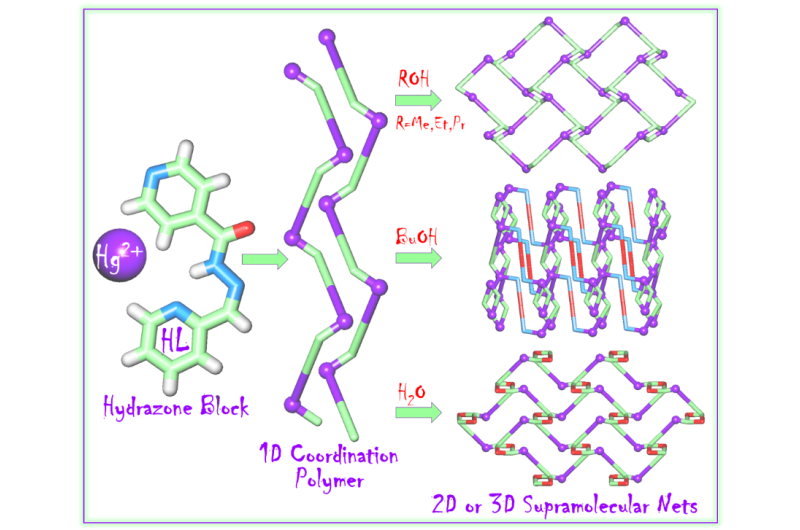Chemists obtained new compound for molecular machines

RUDN chemists and their colleagues have developed an innovative method of crystallisation to produce a new complex mercuric compound with hybrid organic and inorganic ligands and a highly unusual structure. Compounds such as these can be used to create molecular machines—molecules capable of mechanical work. The results were published in Inorganic Chemistry.
In this work, scientists synthesised substances called coordination complexes, containing coordination chemical bonds created between acceptor and donor atoms with a common electron pair. These complexes were produced through the solvometric method by means of increased pressure, and at temperatures above the boiling point at normal atmospheric pressure.
To obtain this compound, the scientists employed non-covalent interactions (hydrogen and halogen bonds) to assemble molecular building blocks into supramolecular architectures with precise dimensions, topologies and motifs. "We demonstrate assemblies formed by a combination of several noncovalent interactions, including stacking interactions between the chelate rings and several anionic coligands, conventional π-π interactions, and σ-hole based chalcogen bonding interactions," said the leading author Ghodrat Mahmoudi, assistant professor of inorganic chemistry, RUDN University. "We extended our research and made it more specific in order to to get a better understanding of the role non-covalent interactions play in chemistry. This research is a logical continuation of our work on analysis and characterization of anion-π, and π-hole interactions in metal complexes. The subject is of great interest to experts in inorganic chemistry. Our results would contribute to extending the knowledge of these interactions."
However, this work has application in another field, apart from fundamental inorganic coordination chemistry—namely in supramolecular chemistry, which concerns "over-molecular" interactions. This branch of chemistry studies more complex systems bonded by non-covalent interactions.
The remarkable characteristic of the complexes produced in this research is their ability to form coordination polymers that don't stop the process at this stage. These polymers can form self-assembled two- and three-dimensional supramolecular reticulate architectures if situated in a different solution. This property might find a use in the production of molecular machines.
The researchers studied chemical properties of this new materials by means of elemental analysis (detection of mass content of different chemical elements in a compound and their ratio), infrared spectroscopy (this method allows researchers to find particular elements in combination because of their different light absorbing capacity), and single-crystal X-ray diffractometry, which shows the structure of compound through the X-ray diffraction of this structure.
Besides experimental measurements, the chemists conducted Density Functional Theory calculations, a method that allowed them to calculate electronic molecular structure with wave functions of atoms. This theory was employed in order to investigate the structure of the new compounds. Such a combination of methods made it possible to increase the accuracy of results.
The team has also systematically studied the influence of the halide/pseudohalide ligands (those compounds which act as donors of the electron pair) and metal salts on the chemical and structural identity of the products.
More information: Ghodrat Mahmoudi et al, Ligand-Driven Coordination Sphere-Induced Engineering of Hybride Materials Constructed from PbCl2 and Bis-Pyridyl Organic Linkers for Single-Component Light-Emitting Phosphors, Inorganic Chemistry (2017). DOI: 10.1021/acs.inorgchem.7b01189
Journal information: Inorganic Chemistry
Provided by RUDN University



















